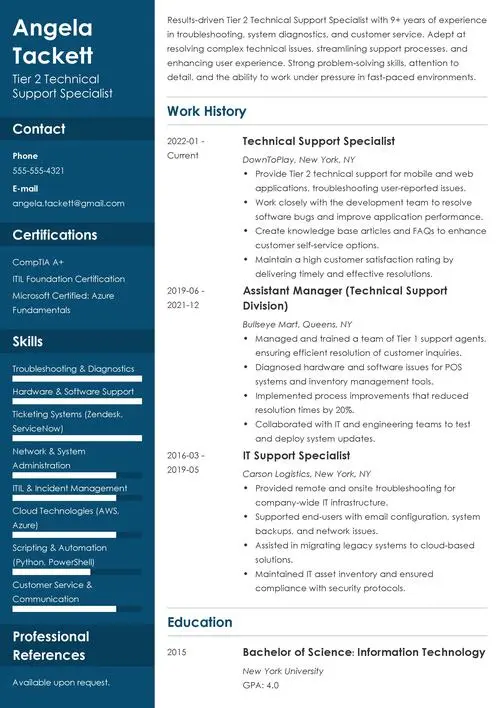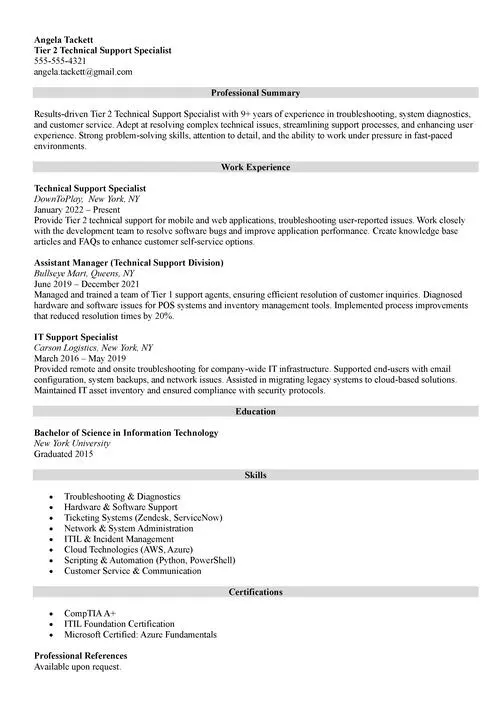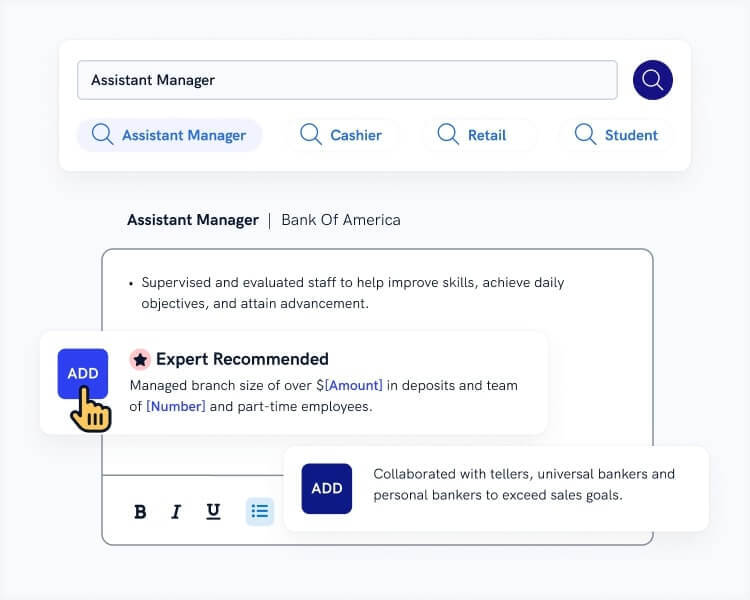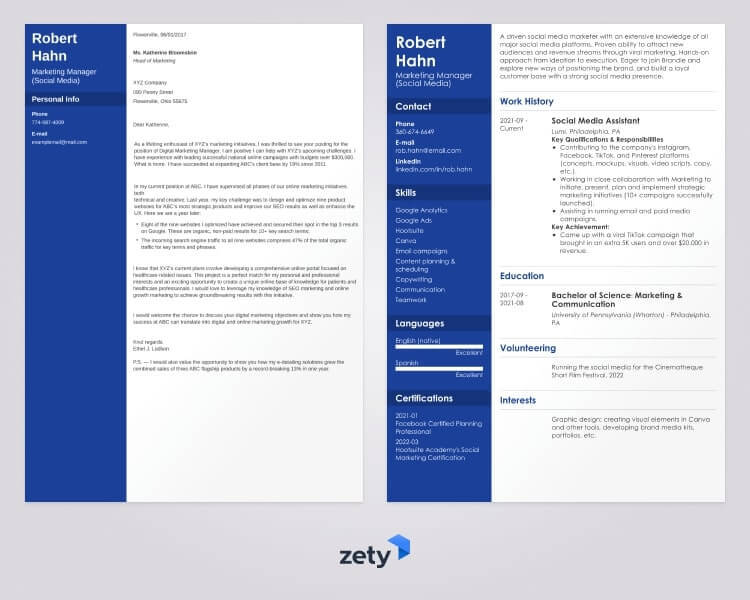Should you add references to a resume? If so, then how to include references on a resume?
And is there a template for a references page for a resume?
These tricky questions need to be answered before you reach out to your previous colleagues for a good word. Professional references on resumes might be required in your situation. But they can also be a miss. So let's find out which one it is!
This resume references guide will teach you:
- Should you put references on a resume or not.
- How to put references on a resume the best way possible.
- How to make a reference page for resumes and job applications.
- How to format a resume references example properly and present it effectively.
Want to save time and have your resume ready in 5 minutes? Try our resume builder. It’s fast and easy to use. Plus, you’ll get ready-made content to add with one click. See 20+ resume templates and create your resume here.
Sample resume made with our builder—See more resume examples here.
One of our users, Brittanya, had this to say:
Zety really helped me create the best resume possible. It pointed out how things could be better on my existing resume and suggested many things to be re-worded or removed.
Are you looking for more guides leading to writing the perfect resume? See:
- Things to Put on a Resume
- Important Skills to Put on a Resume
- Reference Letter Sample
- Should I Put My Address on My Resume
- How Many Jobs Should Be on a Resume
- How to Make a Resume Fit on One Page
- How to Tailor Your Resume
- How to Choose the Right Resume Font
- How to Email Your Resume
- Resume Dos and Don'ts
Should You Put References on a Resume?
Back when I got my first job, references on a resume were commonplace. My advisor in high school even told me to do it. But, just like with most peer-pressured decisions in high school, it is not what I would do now.
Currently, career consultants and hiring managers all agree that references should not be put on a resume. Is that a solid no, though? Well, there are special circumstances when you can include resume references, but you’ll know them when you see them. Generally, if the job listing or hiring manager specifically asks for a references page, then, by all means, include one!
However, if you can’t decide whether to put references on the resume, then don’t include them. Stick with a resume without references. And even if you’ve concluded that you will be listing references on a resume, hold off for now. In the earliest stages of the hiring process, there isn’t a need to provide your chosen references for job applications just yet. Plus, you can tailor your resume reference page to the hiring managers' and company’s needs as you learn more about them during the initial phases of the hiring process and interviews.
But before you decide, let’s see how to include references on your resume.
Want to make a resume that will hook every recruiter and get you that interview? Get our free checklist and learn what makes a job-winning resume: Best Resume Tips
How to List References on a Resume
If you’ve decided that listing references on a resume can’t be avoided in your situation, it’s necessary to know how to list references on a resume the right way.
Here’s how to list references on a resume:
- Use a separate reference page for a resume.
- Put your name and the title "References" on the top of the page, e.g. "John Doe References."
- Use consistent formatting for all your resume references: list their full names, professional titles, companies, and contact information.
- Apply the rule of three and include at least three professional references.
- Ensure you inform all of your references before submitting a job application with their contact details included.
I know a nice resume references template that will make it easier for you:
Reference name
Title
Company name
Street address
City, ST, ZIP code
Telephone number
Email address
Now let’s see some practical examples of resume reference page list entries:
| Right |
|---|
Joelle Smith |
| Wrong |
|---|
Joelle Smith |
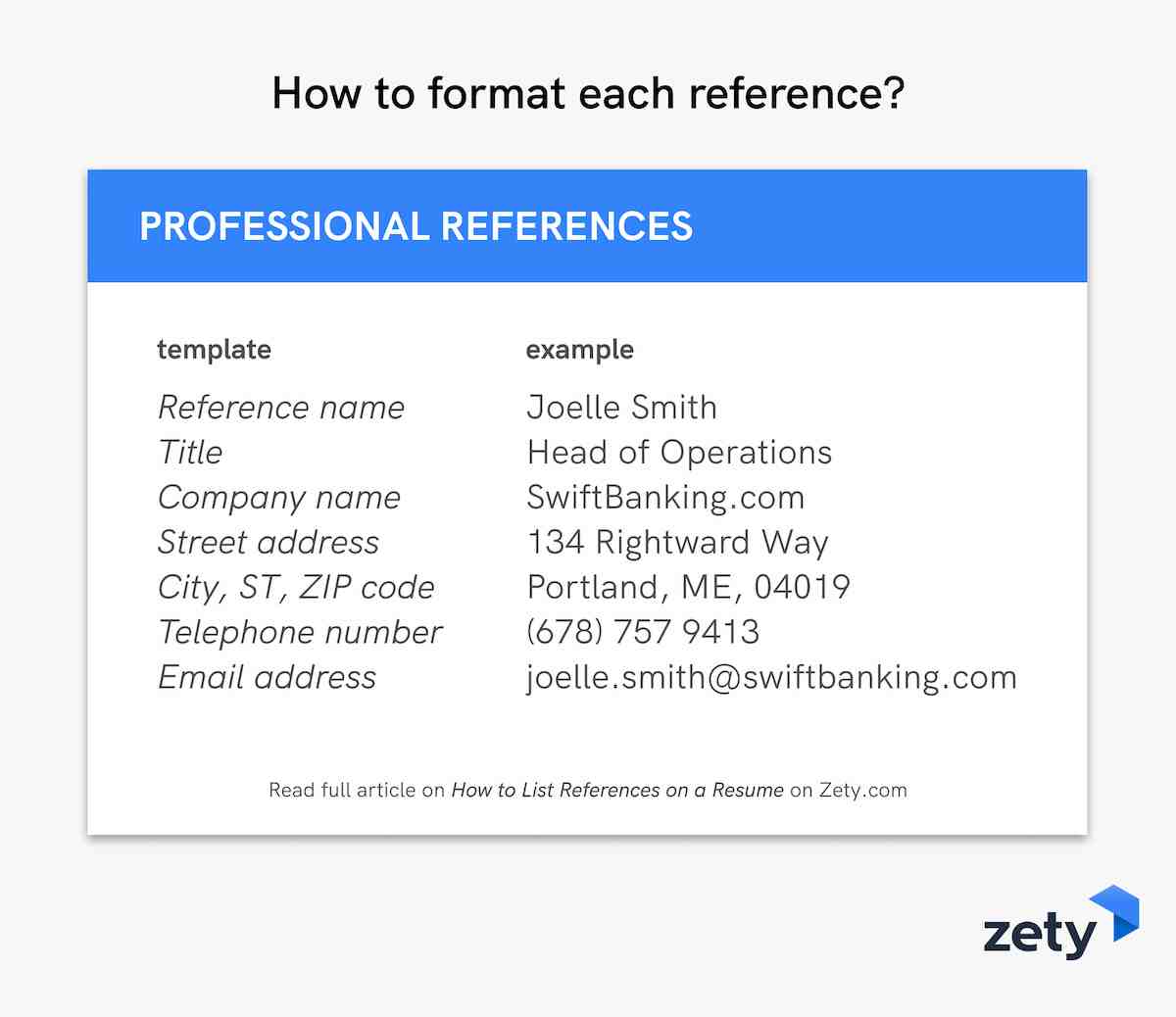
As you can see, the first example is complete, while the other doesn’t give enough information about your reference. What is this person’s job title, and where have you worked with this person? It’s crucial to let your recruiter know that immediately.
That’s how you format each entry of a resume reference list. Include as much as possible, and don’t add more than these items unless requested. Let’s answer one more question.
Should Resume References Be on a Separate Page?
Yes. Always avoid the ubiquitous “Resume references available upon request” statement of the past. Not only are you wasting your resume’s valuable real estate, but they know that your references are available upon request. If you’re going to create a resume references section, use a dedicated resume references page, which you can add as the last page of your application.
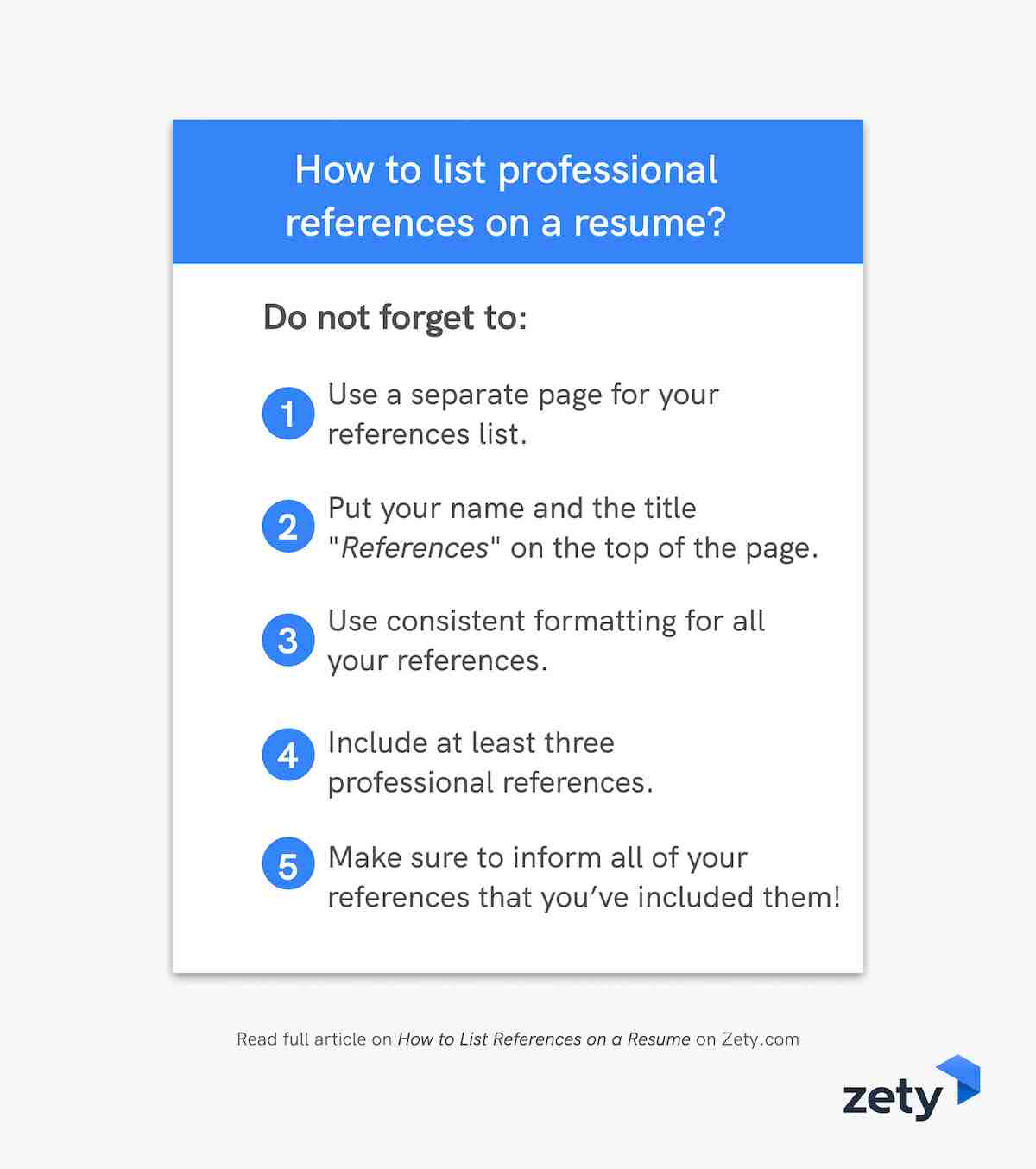
How many references on resumes? Don’t worry, we’ll get to that in just a moment.
Pro Tip: Use LinkedIn as a resource to verify that you are stating the correct job titles.
Creating a resume with our builder is incredibly simple. Follow our step-by-step guide and use content from Certified Professional Resume Writers to have a resume ready in minutes.
When you’re done, Zety’s resume builder will score your resume and our resume checker will tell you exactly how to make it better.
How to Choose Professional Resume References & How to Request Them
You will put a few references as a list to be included with your next resume. But you’ve got to be picky, and you need to ask permission first, even if you’re sure they won’t mind.
So, how many references should you have on a resume?
If the job description or the company have specifically requested that you include a list of references (and this should really be the only reason that you do), three to five strategically chosen people are just right. Any more and you’re just wasting people’s time; any less and you’ll look like you don’t have too many people who can afford you a positive endorsement.
But how do you choose the right people for your references?
The best references to add are working professionals related to the industry you are applying to but unrelated to you in a familial sense. Try to get as diverse a group as possible (not all direct supervisors).
Here are eight types of people to include on your resume references list:
- Former employer
- Former boss (can be your direct manager)
- Supervisor (not necessarily your direct manager)
- Colleague (coworker or teammate)
- Mentor (can be your teacher or professor)
- Advisor (including your academic advisors)
- Business or project partner
- Friend (but only when they currently work at a company you're applying to).
Just make sure to include people who can speak positively about your experience, skills, and work ethic. Never list someone who is or was in any type of professional conflict with you. And don’t just jot down names on your resume references list as they pop into your thoughts. It is polite to ask first, but this gives you the additional perk of checking to make sure their contact information is correct. Give a call or send an email to be semi-formal. And finally, when you get the job, take them out for a nice dinner to pay them back!
Let’s move on to formatting the references on your resume.
Pro Tip: Be sure to thank your references by sending a quick follow-up email or note. Not only is this the courteous thing to do, but it will also remind them that they can expect a call in the near future from your prospective employer.
4. How to Format the Resume References Page
To properly list job references on a resume in 2025, do so on a separate reference page attached to your resume.
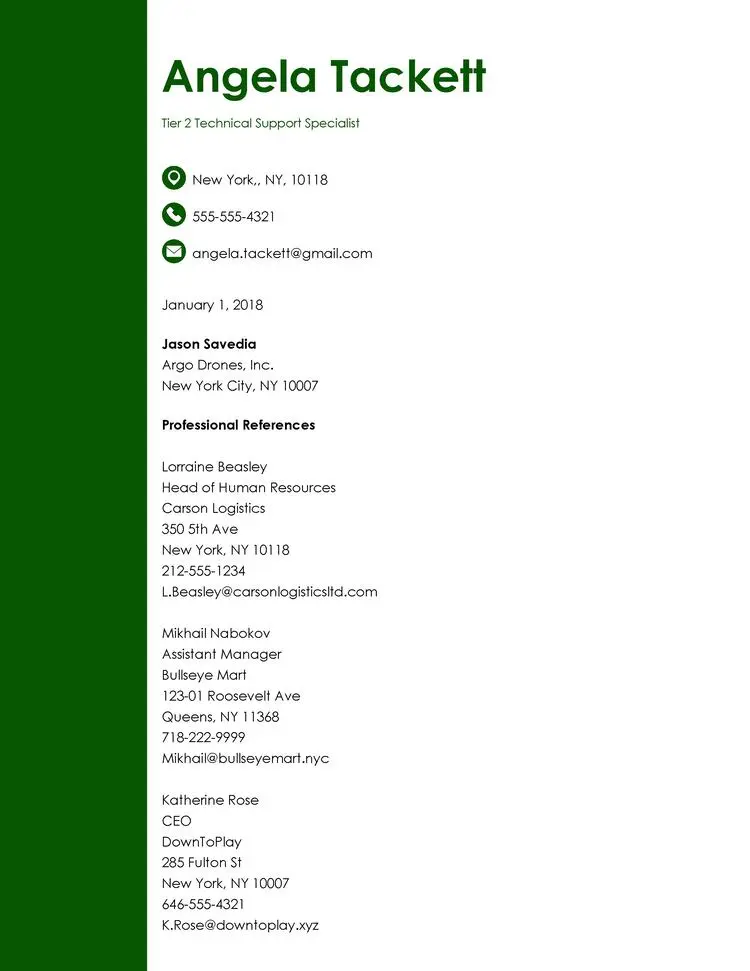
This is how to write a professional resume references page for your resume:
- Format your references page the same way you format your cover letter, and possibly format your resume, too. If you have slight differences between your resume’s letterhead and the one on your cover letter, copy the cover letter.
- Put your name and address on the very top, and it can be left-, right-, or center-oriented (follow the same style as your other documents). Include your phone number and email address.
- Follow that with the date, then the company address, left-aligned above your first reference entry: first the recruiter’s name (if you have it), then the company’s name, and then the company’s address.
- Add reference titles/subtitles such as “References” or “Professional References” before listing 3-5 entries of people who can vouch for your qualifications for a job. If you have both professional references and personal references, you can add both subtitles.
And that’s it!
When it comes to creating a reference page with Zety, use our cover letter builder. It will be super easy to make it match your resume and cover letter!
Plus, a great cover letter that matches your resume will give you an advantage over other candidates. You can write it in our cover letter builder here. Here's what it may look like:
See more cover letter templates and start writing.
Key Takeaway
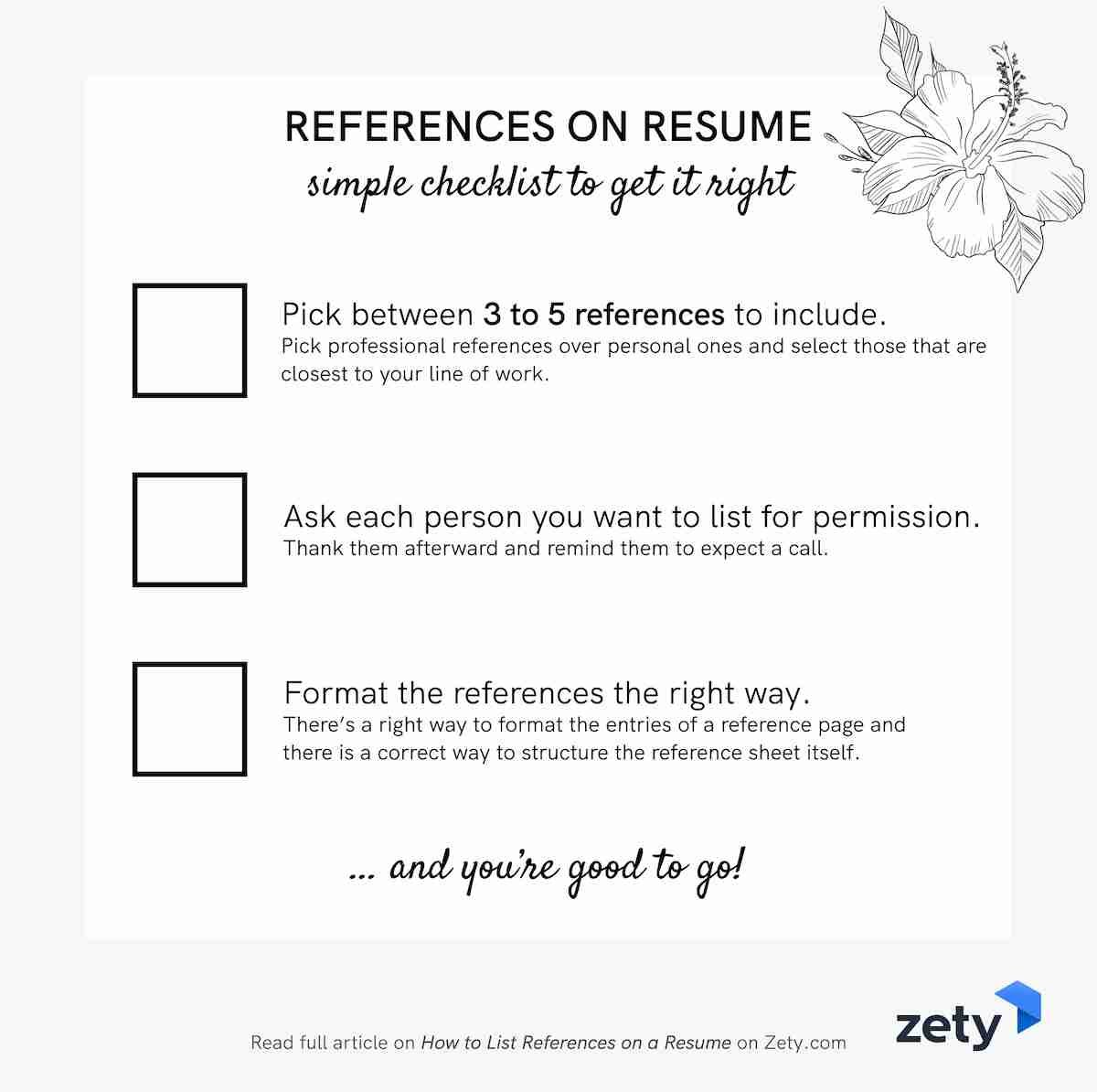
This is how to write a professional list of references for a resume (a references page):
- Choose wisely: You should pick between 3 to 5 references to include if you’ll include any at all. Pick professional references over personal ones, and select those that are closest to your line of work.
- Ask first: Be sure to get permission before listing someone as a professional reference. Thank them afterward and remind them to expect a call.
- Use the right formatting: There’s a right way to format the entries of a reference page, and there is a correct way to structure the reference sheet itself.
About Zety’s Editorial Process
This article has been reviewed by our editorial team to make sure it follows Zety's editorial guidelines. We’re committed to sharing our expertise and giving you trustworthy career advice tailored to your needs. High-quality content is what brings over 40 million readers to our site every year. But we don't stop there. Our team conducts original research to understand the job market better, and we pride ourselves on being quoted by top universities and prime media outlets from around the world.
